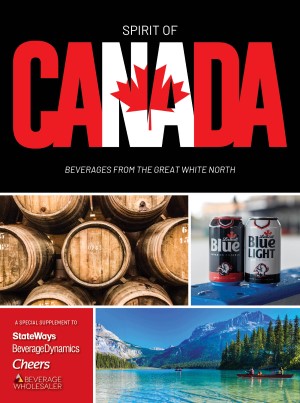PHOTOGRAPHY BY DAN WAGNER
While most Australian wines sold in the US are mass-marketed and brand-driven, the sheer volume of imports Australia is the third-largest exporter of wines to the US, right behind France and closing fast means restaurant customers probably already feel comfortable ordering wines from down under. And if California wine has conquered America, it can be argued that Auistralian wine has conquered the world.
Part of the world, at least. The UK has traditionally been the largest consumer of Australia’s wine, receiving over 40% by value each year. But exports to the US are growing, up to 28% of Oz’s output in value in 2001. Exports to the USA increased significantly since 1992, from $43m to $547m in 2001.
Australians are everyday wine drinkers, the top in the English-speaking world at 5.2 gallons each per year. Today the country is the eighth wine producer in the world (the United States is fourth), with nearly 300,000 acres under vine and more than 1,300 wineries. And with powerful international groups scooping up Aussie wineries, the range and number of wines and labels brought into the US is bound to keep growing.
WHAT’S THE WEATHER?
Most of Australia is dry and hot, with vineyards in need of irrigation, especially in the dry Riverland, Victoria and New South Wales. But the continent/country has as much variation as the continental United States. Two areas are known for wine: in western and southern Australia, the regions of South Australia, Victoria and Tasmania have ideal growing conditions, with winter and spring precipitation and dry, hot summers with warm evenings, usually yielding in moderate acidity.
To the north and northeast (New South Wales and Queensland), tropical influences spread precipitation over the year. The climate here is more problematic with rain in late summer and fall, and dry winters and springs.
About 60% of Australia’s wine is produced in South Australia. Within this area are the regions best-known in the US: Barossa and Clare Valley regions north of Adelaide, often hailed for shiraz; McLaren Vale known for sauvignon blanc; Coonawarra in the south known for cabernet sauvignon and shiraz; and Hunter Valley near Sydney, known for chardonnay.
Most wine production in Australia is controlled by four very large companies: Southcorp, BRL Hardy (now part of Constellation Brands), Orlando Wyndham (owned by Pernod Ricard), and Beringer Blass (owned by Foster’s Group). Southcorp (owner of Penfolds, Lindemans, Wynns, and Rosemount) controls 30% of Australia’s fine wine production.
While the buttery, tropical fruit chardonnays and spicy cabernets are US favorites, it’s shiraz, the local word for the French Rhone blend grape syrah, that is Oz’s leading wine grape. Cabernet, chardonnay, riesling, sémillion and muscat (for dessert wines) are the other important grapes.
Shiraz was the country’s first modern international success, known for producing bold and spicy fruit-forward wines, with notes of mint and eucalyptus, from either straight shiraz or a blend.
Australian white wines tend to be full-bodied and ripe in style, with tropical flavors and moderate acidity. Chardonnay is the most important varietal, with the best offering notes of apple, pear, butterscotch and pineapple. But you’re just as likely to find citrus-and minerally-rich chardonnays, unoaked and bright. French oak barrel aging is common, however.
Other than chardonnay, sémillon is the white variety Aussies prize for herbal and lanolin flavors. Sémillon (pronounced SEM-eh-lon here), which offers a nutty flavor, an unusual treat for Australians, can last many years in the bottle.
WHAT’S IN A NAME?
Australians label their wines with varietal names following similar rules as do Americans; wines are made entirely or mostly (85%) from the single grape variety named on the front label. Frequently, the wines are blended across both regions and varietals, historically a standard practice in Australia. In fact, the Aussie winemaker’s ease with blending has been exceptional in an international business more often hamstrung by traditional rules. It helps that the wines have won favor at home and abroad.
In the matter of style, fruit and freshness are guiding lights. Terroir is undervalued, and the Australian winemaker’s skills emphasized. With production mechanized, and the wines made in modern and sophisticated facilities, winemaking in Australia can fairly be described as high-tech. Australian winemakers take on the latest scientific techniques to advance winemaking into the 21st century.
But it took until the 1990s for the country to tackle a geographical indicator system similar to France’s AOC. Spurred by the goal of continuing growth in Europe, Australia introduced new wine laws and created the Geographical Indications (GI) system. The GI registers wine zones, regions and sub-regions, with wines originating from the area where its grapes are grown, not where the winery is located. In blended wines, GI’s and varietals are described and presented in descending order of their proportions in the blend, with wineries approved for GI guaranteeing that 85% of their fruit from the named region.
In recognition of Australia’s history of blending between remote vineyards, Australia created the huge South Eastern GI. This zone serves as an umbrella to bulk wine producers and allows blending as long as no geographical origin is claimed more specific than South Eastern Australia.
WHERE IT’S AT
South Australia is the powerful engine of the Aussie wine industry, producing about 45% of the country’s total. The oldest name in vinous Australia, the Barossa Valley, is home to many producers, controlling one-quarter of total Australian production. The area features a wide range of soils and microclimates, and is known for shiraz, cabernet, grenache and riesling.
Eden Valley is home of riesling with great intensity. Northwest of the Eden Valley lies Clare Valley, a long, picturesque district full of eucalyptus. The Clare Valley is known for shiraz, sémillon, cabernet and riesling.
Coonawarra’s prime “Terra Rossa” is nine miles by one mile and is considered the Australian Médoc, known for cabernet sauvignon distinguished by mint flavors, and shiraz, with overtones of cedar, cherry and black pepper.
South of Adelaide, McLaren Vale is one of the few regions where sauvignon blanc leads the pack. Padthaway is best known for chardonnay, and some sauvignon blanc.
Other important districts include cool and windy Adelaide Hills, the very hot Adelaide Plains, known for shiraz and home of Penfolds Grange.
New South Wales is often called the spiritual center of Aussie wine production and the second largest wine state.
Hunter Valley grows about 60 different varieties of grapes. “The Hunter,” as it’s known locally, is 100 miles from Sydney, the best known of NSW’s wine districts and a popular tourist destination. Lower Hunter Valley is hot and damp, known for sémillon, shiraz and chardonnay. The Upper Hunter Valley also produces chardonnay and sémillon. The dry whites are known for their richness and depth.
Mudgee is located at a moderate elevation and is best known for deep red, earthy cabernet sauvignon and shiraz, though it also produces other varietals including chardonnay, riesling and sémillon.
Other NSW wine-producing areas include Riverina, Cowra (several hours west of Sydney), Port Stephens, Camden and Canberra.
Victoria, in the far southwest corner of the continent squeezed between South Australia and New South Wales, is known for producing a wide range of wines that are fragrant and full. It also possesses a huge variety of growing areas and makes wines in many styles. The area boasts the largest number of wineries in Australia.
Goulbourn Valley, 70 miles north of Melbourne, has easy access to water and is the best area in the state for full-flavored red wines. Shiraz has been a success, as has marsanne and full-flavored chardonnay.
An hour’s drive from Melbourne is the Yarra Valley, the second coolest region in the state, known for its rolling hills and vineyards featuring a variety of grapes including chardonnay, cabernet sauvignon and pinot noir, and where sparkling wines do well.
Just north of the coastal city of Geelong is Pyrenees, a cool area known for pinot noir. Harsh soils, cold winters and warm, mostly dry summers produce flavorful cabernet sauvignon and shiraz.
Western Australia has a difficult climate, but is one of the fastest-developing wine regions in the country. Between 1997 and 2001, new plantings increased over 80 percent, and wine production grew accordingly.
Margaret River’s cool maritime climate is more influenced by the ocean than any other Australian region. The area concentrates on cabernet sauvignon, shiraz and merlot, and excellent chardonnay and sémillon.
Tasmania produces some delicate pinot noirs and chardonnays.
Other states which make small amounts of wine include the Northern Territory, particularly Alice Springs and Queensland, with the districts of Granite Belt, Atherton Tablelands and Roma.




